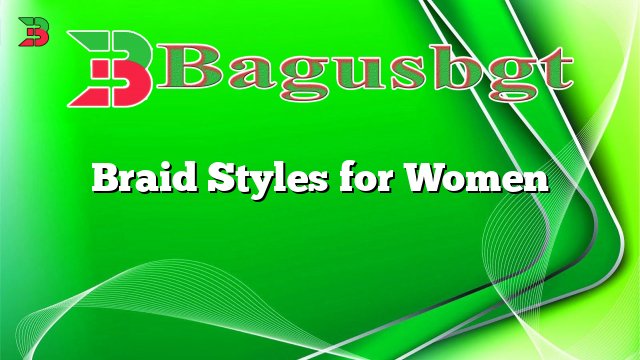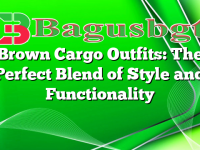Hello, ladies! Are you looking for a trendy and stylish hairstyle that can elevate your look? Look no further than braid styles for women. Braids are not only versatile but also offer various options to suit different occasions and preferences. In this article, we will explore different braid styles, their advantages, disadvantages, and alternative options. So, let’s dive in and find the perfect braid style that suits you!
1. French Braids
French braids are a classic choice that never goes out of style. They are created by weaving three strands of hair together from the crown of the head to the nape of the neck. French braids can be worn casually or elegantly, making them suitable for both everyday wear and special occasions. They are known for their neat and polished appearance.
Advantages: French braids keep your hair secure and tangle-free for a long time. They are also suitable for various hair types and lengths.
Disadvantages: French braids require some practice to master the technique. They can also be time-consuming, especially for intricate designs.
2. Dutch Braids
Similar to French braids, Dutch braids involve weaving three strands of hair. However, in Dutch braids, the strands are crossed under each other instead of over. This creates a braid that appears more raised and prominent. Dutch braids are trendy and perfect for adding volume to your hair.
Advantages: Dutch braids are excellent for those with thin or flat hair as they create an illusion of thicker hair. They also stay in place for extended periods, making them ideal for active individuals.
Disadvantages: Dutch braids may require assistance from another person, especially for beginners. Creating symmetrical Dutch braids on your own can be challenging.
3. Fishtail Braids
Fishtail braids are intricate and eye-catching. They are created by splitting the hair into two sections and crossing small strands from each section over to the opposite side. This process is repeated until the braid reaches the desired length. Fishtail braids can be worn loose for a bohemian look or tightly for a more polished appearance.
Advantages: Fishtail braids are versatile and can be styled casually or elegantly. They are suitable for various hair lengths and textures.
Disadvantages: Fishtail braids can be time-consuming to create, especially if you have long or thick hair. They may also unravel easily if not secured properly.
4. Box Braids
Box braids are popular among women with natural hair or those looking for a protective hairstyle. This style involves sectioning the hair into small square-shaped parts and braiding synthetic or natural hair extensions into each section. Box braids offer versatility and can be styled in various ways, such as updos or half-up styles.
Advantages: Box braids are low-maintenance and can last for weeks. They protect your natural hair from damage and allow it to grow. They also provide endless styling options.
Disadvantages: Box braids can be heavy, especially if you opt for long or thick extensions. They may also cause tension on the scalp if not installed or maintained properly.
5. Cornrow Braids
Cornrow braids are a traditional African hairstyle that has gained popularity worldwide. They involve braiding the hair close to the scalp in a continuous row. Cornrow braids can be simple or intricate, and they offer endless design possibilities. They are known for their durability and ability to protect natural hair.
Advantages: Cornrow braids are long-lasting and require minimal maintenance. They are perfect for active individuals and those looking to give their hair a break from daily styling.
Disadvantages: Cornrow braids can be time-consuming to create, especially for complex designs. They may also cause scalp tension if installed too tightly.
6. Halo Braids
Halo braids, also known as crown braids, are elegant and feminine. This style involves creating two French or Dutch braids that wrap around the head, resembling a halo. Halo braids are perfect for weddings, formal events, or when you want to add a touch of glamour to your everyday look.
Advantages: Halo braids create a stunning and ethereal look. They keep your hair off your face, making them ideal for warm weather or when you want a fuss-free hairstyle.
Disadvantages: Halo braids may require assistance from another person, especially if you want a perfectly symmetrical look. They can be time-consuming to create, especially for beginners.
7. Waterfall Braids
Waterfall braids are romantic and whimsical. They involve dropping small sections of hair as you braid, creating a cascading effect. Waterfall braids can be incorporated into various hairstyles, such as updos or half-up styles, to add a touch of elegance.
Advantages: Waterfall braids create a soft and feminine look. They are versatile and can be styled for both casual and formal occasions.
Disadvantages: Waterfall braids may require some practice to master the technique. They can be time-consuming to create, especially for intricate designs.
8. Rope Braids
Rope braids, also known as twist braids, are created by twisting two sections of hair around each other. This creates a beautiful spiral effect that resembles a rope. Rope braids can be worn as a standalone style or incorporated into other hairstyles for added texture and interest.
Advantages: Rope braids are relatively easy to create and can be done quickly. They offer a unique and eye-catching look.
Disadvantages: Rope braids may require some practice to achieve a neat and uniform appearance. They may also unravel easily if not secured properly.
9. Milkmaid Braids
Milkmaid braids are a charming and whimsical hairstyle that adds a touch of romance to any look. This style involves creating two braids on each side of the head and wrapping them across the crown, resembling a milkmaid’s headdress. Milkmaid braids are perfect for weddings, festivals, or when you want a bohemian-inspired hairstyle.
Advantages: Milkmaid braids create a romantic and ethereal look. They are versatile and can be dressed up or down depending on the occasion.
Disadvantages: Milkmaid braids may require assistance from another person, especially if you want a perfectly symmetrical look. They can be time-consuming to create, especially for beginners.
10. Twist Braids
Twist braids, also known as Senegalese twists, are created by twisting two strands of hair together. This style offers a sleek and elegant look. Twist braids can be worn as a protective style or as a way to add length and volume to your natural hair.
Advantages: Twist braids are low-maintenance and can last for weeks. They protect your natural hair and allow it to grow. They also provide endless styling options.
Disadvantages: Twist braids can be time-consuming to install, especially if you have long or thick hair. They may also cause scalp tension if installed too tightly.
Alternative Options
If you’re looking for alternative options to braid styles, there are several options to consider:
– Updos: Updos are versatile and can be customized to suit any occasion. They can be created with twists, braids, or a combination of both.
– Ponytails: Ponytails are a classic and simple hairstyle that can be elevated with accessories or by adding twists or braids.
– Half-up Styles: Half-up styles offer the best of both worlds. They keep your hair off your face while allowing the rest to flow freely.
– Top Knots: Top knots are stylish and effortless. They can be created with braided or twisted sections of hair for added interest.
Braid Styles for Women – Complete Guide
Braid Style |
Advantages |
Disadvantages |
|---|---|---|
French Braids |
Secure, versatile |
Requires practice, time-consuming |
Dutch Braids |
Adds volume, stays in place |
May require assistance, challenging for beginners |
Fishtail Braids |
Versatile, suitable for various hair lengths |
Time-consuming, may unravel easily |
Box Braids |
Low-maintenance, protective, endless styling options |
Can be heavy, may cause scalp tension |
Cornrow Braids |
Long-lasting, minimal maintenance, protects natural hair |
Time-consuming, may cause scalp tension |
Halo Braids |
Elegant, keeps hair off the face |
May require assistance, time-consuming |
Waterfall Braids |
Soft and feminine, versatile |
May require practice, time-consuming |
Rope Braids |
Unique and eye-catching |
May require practice, may unravel easily |
Milkmaid Braids |
Romantic and ethereal, versatile |
May require assistance, time-consuming |
Twist Braids |
Low-maintenance, protective, endless styling options |
Time-consuming to install, may cause scalp tension |
Braid Styles for Women – Complete Guide
Now that you have a complete overview of various braid styles for women, it’s time to choose the one that suits your personality and occasion. Whether you opt for the classic French braid, the trendy Dutch braid, or the intricate fishtail braid, you can’t go wrong with these stylish options.
Remember, each braid style has its own advantages and disadvantages. Consider factors such as your hair type, length, and the amount of time you’re willing to invest in styling. You can also experiment with alternative options like updos, ponytails, half-up styles, and top knots for a different look.
In Conclusion
Braid styles for women offer a wide range of options to suit every taste and occasion. From French braids to twist braids, each style has its own unique charm. Whether you want a sleek and elegant look or a romantic and whimsical vibe, braids can transform your hairstyle and elevate your overall appearance.
Remember to take into account the advantages and disadvantages of each braid style before making your choice. Consider your hair type, desired level of maintenance, and the occasion you’ll be wearing the braid for. With proper care and maintenance, you can rock any braid style with confidence and style.
So, go ahead and embrace the beauty and versatility of braid styles for women. Get creative, experiment with different designs, and enjoy the compliments that come your way!
FAQ (Frequently Asked Questions)
1. How long does it take to create a braid style?
The time required to create a braid style depends on the complexity of the design and your level of expertise. Simple braids like French or Dutch braids can take around 10-20 minutes, while more intricate styles like fishtail braids or cornrow braids may take up to an hour or more.
2. Can I wear braid styles if I have short hair?
Yes, you can still wear braid styles even if you have short hair. Some braid styles may require the assistance of extensions or hairpieces to achieve the desired look. Consult with a hairstylist to determine the best options for your hair length.
3. How long can I keep braids in?
The duration you can keep braids in depends on various factors, including the braid style, your hair type, and how well you maintain them. Generally, braids can last anywhere from a few days to several weeks. It’s important to care for your braids properly by moisturizing your scalp, avoiding excessive tension, and protecting them while sleeping.
4. Can I wash my hair with braids?
Yes, you can wash your hair with braids. However, it’s important to be gentle and avoid excessive manipulation. Use a gentle shampoo and focus on cleansing your scalp while avoiding the braided sections. Follow up with a moisturizing conditioner and be sure to dry your hair thoroughly to prevent mildew or odor.
5. Can I style my braids in different ways?
Absolutely! One of the advantages of braids is their versatility. You can experiment with various updos, half-up styles, or ponytails to change your look. You can also accessorize your braids with ribbons, beads, or hair jewelry to add a personal touch.
6. Do braids cause hair damage?
If done properly and with proper care, braids should not cause hair damage. However, it’s important to avoid excessive tension, especially at the hairline, to prevent hair breakage. Be gentle when taking down braids and ensure that your hair is properly moisturized and conditioned to maintain its health.






